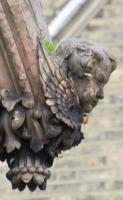
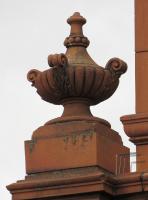
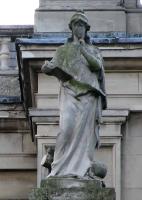
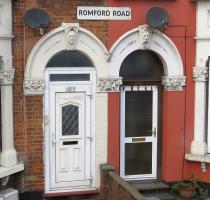
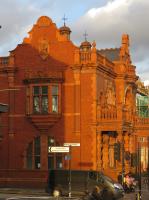
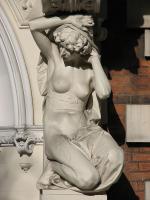
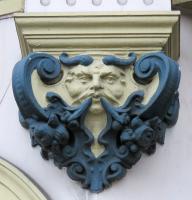
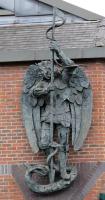
Central Stratford is a mix of modern shopping and transport hub, but there is still sculpture and Victorian and Edwardian buildings to see, including the Stratford Martyrs memorial in terra cotta, a few bits in the Church, before venturing along the interesting Romford Road, where there is the former Passmore Edwards Museum building with good architectural sculpture, the Queen Anne style Earl of Essex pub, the Carnegie Library building in terra cotta, and a fine modern statue of St Michael, and a series of keystone heads on the terraced housing along the way.
Rather a sad way to begin, from the point of view of statues, for they have all gone. The building, a nice pillared Italianate thing, was opened in 1869 no surprise there as the Town Hall of Stratford-atte-Bowe, for the public and parochial purposes of the district of West Ham . The architects were Lewis Angell, surveyor to the local Board, and John Giles of Craven Street. It was enlarged in the 1880s, quoted as being by the architect Giles Angell which is clearly a mangling of the names of the two previous architects.
West Ham Old Town Hall, detail of figures, and the denuded building in 2016. 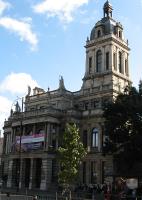
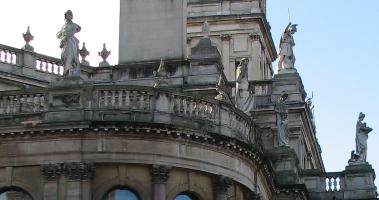
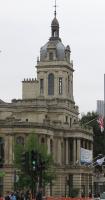
When I saw the building in about 2006 there were six figures upon it at balustrade level, and a couple higher up. Originally there were more as noted in the Illustrated London News: the building is surmounted by various figures and groups of statuary, well executed by Mr Bromfield, sculptor, of Kennington Road. The subjects of these statues and groups are the Arts, Science, Agriculture, Commerce, Industry, Justice, Mercy, Prudence, Fortitude, Temperance, St George, and Britannia . I saw only the eight, which were there at least until 2006 (Pevsner and Cherry, writing some years earlier misquotes them as just five), and some time after that, they were removed. Other than the eight there until recently, from the engraving, there look to be a couple of groups on the top of the tower, so presumably with two on the other sides this would have been the Arts, Science, Agriculture and Commerce, thus twelve in all. The building as it remains is decent enough. It has two principle stories and a third one above a balustrade, and a solid square tower rising at the western end, with its own parapet, mansard roof and cupola at the top. There is a portico, projecting nobly into the streetscape, with rusticated pillars at ground floor and plain ones in the upper level, supporting a balcony. And a couple of tall chimneys survive. But it was the statues which made the roofline and their removal is a loss.
St George, Justice and Britannia statues. 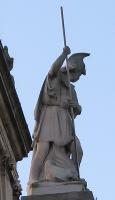
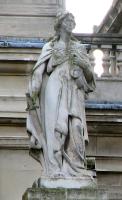
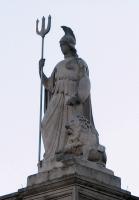
Here are some not very good pictures of them as I saw them.At the top is Britannia, with her trident, small shield, and equally modest lion, and St George, easily recognisable. Of the rest of the allegorical figures, we can easily spot Justice, with her sword, and her other hand, pressed to her breast, loosely holding her scales. But the others are less clear in their decayed state, though the girlish figures and the drapes remain good and a hint at what the sculptor envisaged. (For more statues of Britannia, see this page, for Justice see this page, and for other allegorical statues, see this page.)
Allegorical figures by Bromfield, sculptor of Kennington Road. 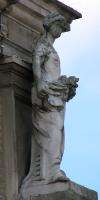
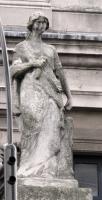
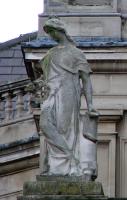
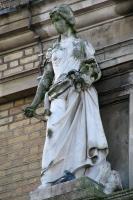
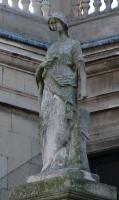
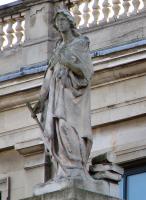
Just outside the bus station in the centre of the road is a tall granite obelisk to Samuel Gurney, banker and philanthropist, a granite obelisk, 40ft high, with a drinking fountain, designed by Mr. J. Bell [the sculptor - see this page], erected in 1861, as a memorial to the late Samuel Gurney, by his fellow parishioners . Alas, there is no sculptural adornment on the obelisk to speak of.
St John s Church itself, built in 1833 in Early English style to the designs of the architect Edward Blore, occupies a prominent position in the High Street where it splits into the Broadway which will become Romford Road and the more northerly branch which eventually bears north to Leytonstone. St John s Church Stratford is a large and commodious structure, of Suffolk brick and Bath stone, Early English in style, with a tower and a short spire . The main external feature is the massive square tower, buttressed, spired and pinnacled. Inside, the Church is tall, well-lit, and open, with wide arches separating the clustered pillars so that the aisles do not feel separated from the nave. The date is too late to expect much by way of sculptural monuments, just a few funerary panels, including one by the mason and sculptor M.W. Johnson and two by the Druitt family, whose most prominent member, Jabez Druitt, had his main premises at 530 Romford Road (see this page).
St John's Church, Stratford, by Edward Blore. 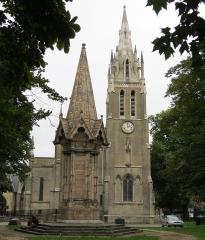
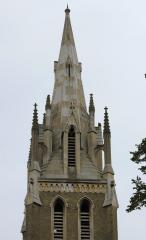
The old Parish Church, All Saints West Ham, is a few minutes walk to the south down West Ham Lane. It contains excellent monuments and really should be visited by anyone who likes sculpture, and is described on this page. The sculptors include Edward Stanton, perhaps Henry Cheere, Henry Hopper, and M.W. Johnson, whom we met in St John's Church, is represented by several works.
Outside stands the pale terracotta Stratford Martyrs Memorial, which is noted on the Stratford Church page.
As we start along Romford Road, on the north side by Water Lane is the former Technical Institute, Library and Passmore Edwards Museum, now part of the University of East London. It is decorated with much allegorical sculpture, and is the subject of a separate page. We note here only that at least the caryatid sculpture by the main entrance is by the sculptor Birnie Rhind - one of them is shown at the top of this page. Notice too the H.C. Fehr bronze panel where the museum door was, with a relief portrait of Passmore Edwards himself, and the Coade stone statue of Shakespeare by the Water Lane entrance.
Passmore Edwards Museum and Library, one of the architectural figure sculpture groups, and Shakespeare statue. 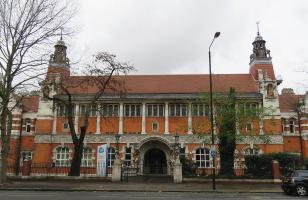
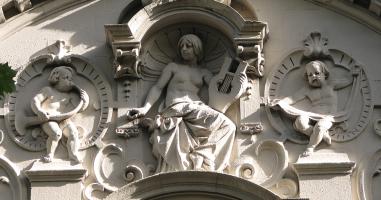
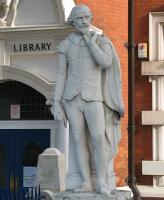
Going further, a feature of Romford Road are the keystone heads on several ranges of the terraced Victorian houses. There are a variety of types females and bearded men with leafy hair. I particularly liked the one with a fireman s helmet. I have a penchant for keystone heads - for an introduction to the subject see this page, for bearded male ones see this page, and for female ones see this page
Keystone heads along Romford Road. 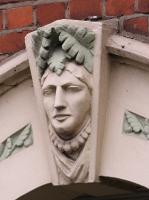
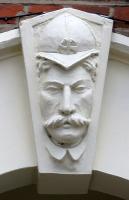
It stands on the corner of High Street North, by Woodgrange Park and Manor Park stations, no. 616 Romford Road, a cheerful Queen Anneish Classical baroque thing, in white stone and stucco and red brick. It features a corner turret, appearing round but actually octagonal, with a nice dome and pointy spire rising to a weathervane. The roofline is given variety with tall chimneystacks, little balls, and a further pointy spire on the Romford Road side. At the first floor level of the turret, there is a recessed window behind a balcony with pillars and arches at first floor level. There is another balcony round the side above the principal entrance, which is set forward with curved sides. Above is a curved, broken pediment containing sculptures of two cherubs on either side of a circlet which may once have contained a clock; they hold the ends of a festoon of fruit and flowers, and in their other hands hold respectively a cornucopia and a leafy branch. If you like cherub sculpture see this page. Other decorative features include supporting corbels bearing the heads of satyrs moulded in high relief, and a broader supporting corbel notes that the building was erected in 1902, the Coronation year, by the architects Henry Poston and W.E. Trent, with W.J. Maddson as the builder.
Next, on the north side by the unusually-named Rabbits Road, is the Carnegie Library, an example of a Terra Cotta building more familiar in kind in Birmingham and the great northern cities than London. It is not so large, five bays wide to Romford Road, each window of the central three bays with a beautiful broad arch, and with Arts and Crafts stained glass in the upper level. The central portion is set somewhat forward, with pillars and a balcony in front of the upper floor rising to a central gable with a further curved balcony at balustrade level.
Carnegie Library, Romford Road, 1904/5. 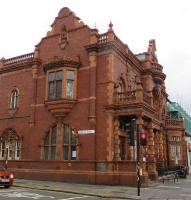
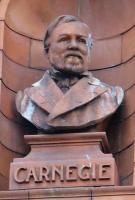
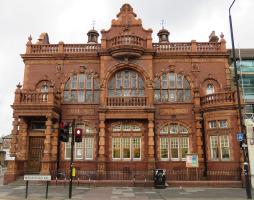
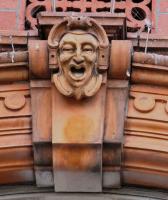
Above and behind on the shallow roof are a pair of small cupolas to either side of the gable. The entrance is at the corner, a pillared porch with broad balcony above, and balanced at the fifth bay with an equally prominent curved bay, again with balcony at first floor level. The building is made in pale terra cotta and darker red glazed tile, and in nicely decorated with repeated patterning. The names of Milton, Shakespeare, Tennyson and Carlyle are below the balustrade (Dickens and Longfellow are lower down), and below that, niches contain a pair of small terra cotta lions. There are several ornate terra cotta pots, including four above the entrance, which also has the sign Free Library and Let there be light in 1900s text at first floor level; across from this on the main frontage panels say Carnegie Library . The keystones of the ground floor windows are modelled with grotesque heads. The side to Rabbits road bears more minor decorative elements, but contains a niche with a bust of Carnegie, the American philanthropist donor the library and so many other good things (Diplodocus Carnegii is named after him, by his grateful nephew who was funded by Carnegie both to go on dinosaur-hunting expeditions, and to have a museum). A plaque below gives the date the building was erected: 1904 (it opened the following year) and the architect, A. H. Campbell.
We end our perambulation along Romford Road a little past this: the road on the south side is Fourth Avenue, and between the imaginatively called 6th and 7th Avenues, but again on the north side, is the Church of St Michael and All Angels Romford Road. It is a modern building, but of interest to these pages for the spirited modern sculpture upon it showing a figure of an angel, or king with angel s wings, stabbing a small dragon with a spear - see pictures below and at top of page, far right. Left in a harsh, unsmoothed state, the bronze or bronze resin figure has the look of some charcoal illustration of the early 20th Century, and is to be commended for its vigour and power.
Passmore Edwards Museum building // close by: South to West Ham Church // or north west to Leyton Church
Other London sculpture // Architectural sculpture // Allegorical sculpture
Visits to this page from 23 Mar 2017: 5,556